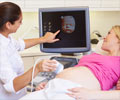New cardiac catheter combines both intravascular ultrasound with fluorescence lifetime imaging (FLIm) in a single catheter probe to find plague.
- New device delivers light into tiny blood vessels.
- Light helps intravascular ultrasound see clearer.
- Light and intravascular ultrasound combined offers better diagnosis.
An optical fiber in the catheter sends short laser pulses into surrounding tissue, which fluoresces with tiny flashes of light in return. Different kinds of tissue (collagen, proteins, lipids) emit different amounts of fluorescence.
At the same time, an ultrasound probe in the catheter records structural information about the blood vessel.
Innovation Equals Better Diagnosis, Powerful Treatment
The combination FLIm-IVUS imaging catheter provides a comprehensive insight into how atherosclerotic plaque forms, aiding diagnosis and providing a way to measure how plaques shrink in response to therapy.
The new catheter has been tested in living swine hearts and samples of human coronary arteries.
The catheter used in the study is flexible enough to access coronary arteries in a living human following standard procedures. It does not require any injected fluorescent tracers or any special modification of the catheterization procedures.
Marcu’s group is currently working to obtain FDA approval to test this new intravascular technology on human patients.
-
New Cardiac Catheter Combines Light and Ultrasound to Measure Plaques - (http://blogs.ucdavis.edu/egghead/2017/10/03/new-cardiac-catheter-combines-light-ultrasound-measure-plaques/ )
Source-Eurekalert
















